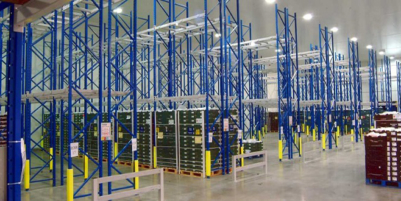-
Nutrivend selects Forterro’s Orderwise to support online expansion and streamline operations - April 11, 2025
-
ARROWXL LAUNCHES AMBITIOUS ZERO WASTE ROADMAP - April 8, 2025
-
THE BCMPA’S NEW CAMPAIGN DRIVES OUTSOURCING SUCCESS IN Q1 - April 7, 2025
-
BLACKOUT TECHNOLOGIES TARGETS TELEMATICS-INTEGRATED MOBILE DEVICE BLOCKING TO COMBAT SMARTPHONE DISTRACTION - April 1, 2025
-
OpenADR Alliance announces first OpenADR 3.0 certified products with EVoke Systems, E.ON Energy and Universal Devices - March 25, 2025
-
Growing fulfilment and contract packer appoints new Managing Director - March 25, 2025
-
When is it time to invest in a WMS? Understanding the key trigger points - March 25, 2025
-
eCapital helps Vantage Recruitment on its journey to financial success - March 24, 2025
-
Hugo Beck Celebrates 70 Years of Packaging Innovation with Open House Events - March 20, 2025
-
PROLOG FULFILMENT SUPPORTS LUNA DAILY’S COMMITMENT TO BETTER BODY CARE FOR ALL WOMEN - March 19, 2025
These are exciting times for UK garment manufacturers – if they embrace digitalisation, writes Karl H. Lauri, managing team member at MRPeasy.com.
Significant changes are under way in the garment and apparel manufacturing industry. In many cases they are both driving and being driven by digitalisation in the sector. If the UK’s many smaller garment manufacturers are to treat these changes as opportunities rather than threats, they need to become part of the emerging digital ecosystem, and the entry level foundation for that is a competent ERP/MRP system.
There are almost 4,000 UK enterprises manufacturing wearing apparel, and 99.7% of these count as SMEs. There are of course further companies in the related fields of textile production, footwear, accessories, not to mention a small army of unincorporated individuals ranging from high-end designers and their networks of artisan makers to the many, often exploited, out- and home- workers. Manufactures range from fashion to workwear, and the factory may be the atelier of a couture house, or a contract manufacturer for retailers and brands. UK companies booked sales of £1.6 billion, at factory gate prices, in 2019 whereas the retail value of UK apparel sales is north of £50 billion. That partly reflects the dominance of cheap, and sometimes ethically dubious, imports in the mass market but also suggests that UK firms are failing to capture as much of the value chain as they could. If they can exploit the emerging trends, UK firms could improve their share significantly.

The ethical and environmental concerns of consumers, increased geo-political trade friction, the post-pandemic emphasis by brands and retailers on supply chain resilience, and rising costs in ‘cheap’ source markets are fuelling some degree of reshoring of manufacture, and a greater appetite by consumers for the local, natural, ethical and ‘authentic’. Fast, throwaway, bulk fashion is less desirable or acceptable. Such shifts do not have to be massive to transform prospects for many small producers.
Demand for customised and personalised apparel is increasing, along with the technologies required to deliver this. IT is providing ‘virtual fitting rooms’, and is beginning to enable consumers to create their own designs – from fabric prints and patterns to shapes, styles, colourways and trims – and is on the verge of being able to use the digital files thus created to instruct largely automated manufacture – ‘robotic’ programmable knitting machines, for example, are already a reality.
The personalisation trend is partly driven by social media, and this is having other impacts. ‘Flash’ sales and product ‘drops’ are increasingly used, even or especially by upmarket brands to create near-guaranteed sell-out ‘events’ for strictly limited editions.
Social media also extends opportunities for smaller manufacturers to develop their own Direct to Consumer lines of trade thus capturing more of the value chain. Retailers and brands are beginning to use Big Data analytics and Artificial Intelligence not only to understand and influence demand, but to spot or even predict ‘micro-trends’ and create or modify designs to suit.
One effect of these trends is that unlike some other manufacturing sectors, such as automotive, which are being forced back from their Just in Time models, significant parts of the garment and apparel industry are moving towards a make-to-order, small batch size, environment. This is reinforcing the requirement for close to market manufacturing, removing some of the disadvantageous economies of scale and, at least in theory, playing to the strengths of the smaller companies, which can be more agile in response to demand changes.
For those smaller manufacturers, the challenges include smaller batches, ever-tighter lead times, and even more rapidly varying order requirements – as it is, orders from retailers and brands can be subject to almost daily variation in terms of size ranges, colourways and delivery destinations and schedules – as data analysis produces ever more granular insights, these variations can only increase. In this environment, manufacturers have to minimise material waste, ensure timely procurement of materials at shorter notice, and make the most effective use of labour – which, whatever the advances in robotics, will always be a key element. Fast and accurate planning and scheduling is key.
They are also under increasing pressure to have documented, auditable systems to prove they are complying with both legal and customer requirements – on use of sub-contractors, Health & Safety, the minimum wage, the source of materials and, because a significant proportion of UK output is exported, providing evidence for Country of Origin and other regulations.
An ERP/MRP base is essential for firms to interact meaningfully with their customers’ B2B web portal, EDI and other systems, and to support any digital D2C business they may develop. How else can the firm make that price and delivery promise in real time? Not every garment manufacturer is immediately faced with the prospect of robotic sewing, unique single consumer designs, or the application of blockchain or predictive analytics, but they all need to book their place in this increasingly digital environment.
ERP/MRP itself does not, of course, deliver digitalisation, but it is a necessary precondition. It establishes a single source of truth, it allows the effective co-ordination of a complex supply chain. including outworkers, with real-time planning and scheduling. It enables effective response to rapidly changing demand and crucially, gives visibility into whether activities and contracts are actually profitable. A well set up system also allows two-way, largely automated, communication with customers and suppliers, taking time, cost and error out of business processes. It is the basis for the verification and audit procedures that customers and consumers are increasingly demanding. It also provides the backbone on which other, more advanced, technologies can in time be mounted.
Cloud-based, Software-as-a-Service ERP/MRP systems such as those from MRPEasy, are now eminently affordable. There are low initial costs for capital equipment, training and implementation, and they are fully scaleable both in functions used and in number of users. The client is paying for usage, so on-costs are proportionate to business activity. Systems are designed for the needs of smaller companies, and routines and applications specific to the garment/apparel industry can be perfected and shared across the relevant user community.
These are exciting times for UK garment manufacturers, if they embrace digitalisation.

































